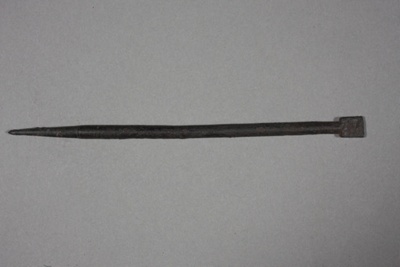< Collection search
< Collection highlights
From:UC Teece Museum of Classical Antiquities
Name/TitleStylus
About this objectThis stylus is made of iron and was most likely used during the first or second century CE. A stylus is a tool used for writing or marking objects, the early version of a modern pen or pencil. This particular stylus was designed to be used with a wax-coated writing tablet. The pointed end was used for writing, by scoring letters into the wax surface, and the flattened end could be used as an eraser, smoothing out the wax to remove mistakes. Wax tablets had an advantage over paper because not only were they cheaper to make, but they were also reusable and could last longer.
This particular stylus is believed to be from the Old Jewry Excavations in London, which were undertaken in 1934. More than 100 styli were recovered from Walbrook Stream in London, perhaps placed there as religious offerings. At that time, people made votive objects out of the tools of their trade.
Some styli could be highly decorated, examples of which can be found in the British Museum collection which were excavated in the same area. By contrast this is a very simple stylus, and the circular tool has only a series of ridges around the gripping point near the writing end, which would have made it easier to hold without slipping.
Date Made1st-2nd Century CE
PeriodImperial (Roman)
Place MadeUnited Kingdom
Place NotesFrom London, found in Old Jewry excavations 1934
Medium and MaterialsMetal: Iron
Style and IconographyRomano-British
MeasurementsLength 139mm; Diameter ca. 5mm
Subject and Association KeywordsWriting, history
Named CollectionThe James Logie Memorial Collection, University of Canterbury, New Zealand
Credit LineDonated by Professor D. A. Kidd, 1978
Object TypeTools and Equipment
Object number163.78
Copyright LicenceAll rights reserved
